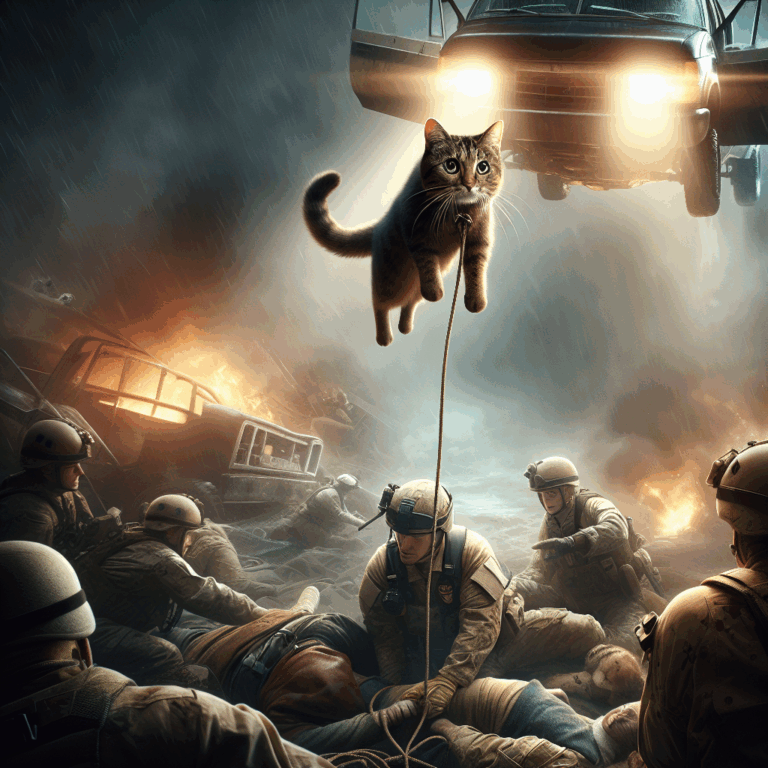The Feline Rescuers: Cats and Their Heroic Acts of Bravery
- One Comment
In a world where heroism often wears a human face, cats are quietly emerging as unlikely champions of bravery. These feline rescuers have demonstrated time and again that courage knows no species. From alerting families to dangers such as fires and gas leaks to rescuing other animals, cats have stepped into the spotlight with their instinctive acts of valor, proving that our feline friends possess heroic qualities that often go unnoticed.
In a recent incident that captivated the hearts of many, a tabby cat named Mittens became a local hero after saving a family from a potential house fire in Springfield, Illinois. In the early hours of the morning, Mittens persistently pawed at her owner’s face until she awoke, just in time to notice smoke seeping through the cracks of the bedroom door. The family, along with Mittens, evacuated safely, with firefighters later confirming that the early alert prevented a potentially devastating loss.
Such stories abound, where cats have been documented to exhibit protective behavior not just towards humans, but also towards other animals. Take, for instance, the remarkable tale of a cat named Felix in rural Mississippi, who alerted his family to the cries of an abandoned kitten stuck in a nearby drainage pipe. Felix’s insistent meowing and pacing near the door led the family to investigate, ultimately saving the helpless kitten from certain peril.
But what drives these acts of bravery in cats? Animal behaviorists suggest that a combination of their acute senses and strong territorial instincts often compels them to act in protective ways. Cats are known for their heightened sense of smell and hearing, which enables them to detect anomalies in their environment long before humans do. This sensory prowess, combined with their natural curiosity, may explain why they often act swiftly in the face of danger.
Moreover, cats form strong bonds with their human companions and other pets, challenging the stereotype of their aloofness. These bonds can manifest in loyalty-driven actions, where cats feel a sense of duty to protect their family and territory. In some cases, cats have even been reported to defend their human companions from potential threats, such as aggressive wildlife or intruders, exhibiting a level of bravery that rivals that of trained guard animals.
The stories of feline bravery are not limited to domestic settings. Cats have also been known to perform acts of heroism in more public arenas. For example, in a busy urban park in Tokyo, a cat named Tama became a well-loved figure after she consistently led rescue workers to stranded animals in distress following a series of natural disasters. Tama’s uncanny ability to locate and alert humans to animals in need underscored the potential of cats to become vital members of search and rescue efforts.
As these tales of feline heroism continue to emerge, they challenge and enrich our understanding of the bond between humans and cats. They remind us that heroism comes in many forms and that our pets are often capable of extraordinary deeds that transcend their perceived limitations. While cats may not wear capes, their acts of bravery serve as a testament to their profound role in our lives, underscoring their ability to protect, nurture, and inspire.
The narrative of the feline rescuer is one that merits greater attention and appreciation, highlighting the extraordinary potential that lies within these seemingly ordinary creatures. As more stories of cat heroics come to light, they not only enhance our respect for these animals but also inspire a deeper connection with the pets we share our homes with, proving that sometimes, heroes come in the form of whiskers and paws.

In a world where heroism often wears a human face, cats are quietly emerging as unlikely champions of bravery. These feline rescuers have demonstrated time and again that courage knows no species. From alerting families to dangers such as fires and gas leaks to rescuing other animals, cats have stepped into the spotlight with their instinctive acts of valor, proving that our feline friends possess heroic qualities that often go unnoticed.
In a recent incident that captivated the hearts of many, a tabby cat named Mittens became a local hero after saving a family from a potential house fire in Springfield, Illinois. In the early hours of the morning, Mittens persistently pawed at her owner’s face until she awoke, just in time to notice smoke seeping through the cracks of the bedroom door. The family, along with Mittens, evacuated safely, with firefighters later confirming that the early alert prevented a potentially devastating loss.
Such stories abound, where cats have been documented to exhibit protective behavior not just towards humans, but also towards other animals. Take, for instance, the remarkable tale of a cat named Felix in rural Mississippi, who alerted his family to the cries of an abandoned kitten stuck in a nearby drainage pipe. Felix’s insistent meowing and pacing near the door led the family to investigate, ultimately saving the helpless kitten from certain peril.
But what drives these acts of bravery in cats? Animal behaviorists suggest that a combination of their acute senses and strong territorial instincts often compels them to act in protective ways. Cats are known for their heightened sense of smell and hearing, which enables them to detect anomalies in their environment long before humans do. This sensory prowess, combined with their natural curiosity, may explain why they often act swiftly in the face of danger.
Moreover, cats form strong bonds with their human companions and other pets, challenging the stereotype of their aloofness. These bonds can manifest in loyalty-driven actions, where cats feel a sense of duty to protect their family and territory. In some cases, cats have even been reported to defend their human companions from potential threats, such as aggressive wildlife or intruders, exhibiting a level of bravery that rivals that of trained guard animals.
The stories of feline bravery are not limited to domestic settings. Cats have also been known to perform acts of heroism in more public arenas. For example, in a busy urban park in Tokyo, a cat named Tama became a well-loved figure after she consistently led rescue workers to stranded animals in distress following a series of natural disasters. Tama’s uncanny ability to locate and alert humans to animals in need underscored the potential of cats to become vital members of search and rescue efforts.
As these tales of feline heroism continue to emerge, they challenge and enrich our understanding of the bond between humans and cats. They remind us that heroism comes in many forms and that our pets are often capable of extraordinary deeds that transcend their perceived limitations. While cats may not wear capes, their acts of bravery serve as a testament to their profound role in our lives, underscoring their ability to protect, nurture, and inspire.
The narrative of the feline rescuer is one that merits greater attention and appreciation, highlighting the extraordinary potential that lies within these seemingly ordinary creatures. As more stories of cat heroics come to light, they not only enhance our respect for these animals but also inspire a deeper connection with the pets we share our homes with, proving that sometimes, heroes come in the form of whiskers and paws.



1 thought on “The Feline Rescuers: Cats and Their Heroic Acts of Bravery”
This article beautifully highlights the remarkable bravery and protective instincts of our feline companions.